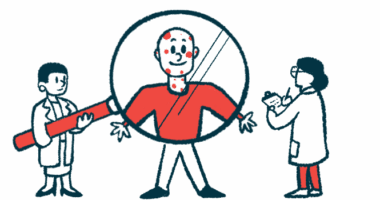More FVIII Antibodies May Predict Outcomes in Acquired Hemophilia A
Higher antibody levels tied to slower response to treatment in new study
High levels of antibodies against clotting factor VIII (FVIII) were associated with a slower response to immunosuppressive treatments in a small group of people with acquired hemophilia A in new study in China.
Of 34 patients, 29 achieved a complete response to their first-line immunosuppressive therapy. Still, a lower proportion of patients with antibody levels at or above 20 Bethesda units per milliliter (BU/mL) of blood achieved a response.
These findings highlight that the level of anti-FVIII antibodies in acquired hemophilia A patients “appears to be an important predictor” of treatment response, according to researchers.
“Future prospective studies or registry analyses should attempt to identify other clinical or laboratory variables affecting time to complete response and overall survival,” the team wrote, adding that “such information will help physicians achieve optimal outcomes.”
The study, “Acquired Hemophilia A: A Retrospective Multicenter Analysis of 42 Patients,” was published in the journal Clinical and Applied Thrombosis/Hemostasis.
Investigating treatment responses in acquired hemophilia A
In acquired hemophilia A, the body’s immune system produces self-reactive antibodies that attack and neutralize FVIII, a protein that’s needed for blood clotting.
Patients are treated with hemostatic or bleed control therapies, as well as immunosuppressants aimed at dampening the body’s production of such autoantibodies.
While about 60% to 80% of patients respond to this immune-suppressing therapy, responses can be delayed for some individuals. Such delays lead to a high risk of fatal bleeding events before the medications take effect.
“It is therefore important to select the appropriate initial therapy,” the researchers wrote, adding that “clinical and laboratory parameters that could predict outcome and guide treatment decisions need to be clearly identified.”
To learn more about preventing delayed therapy responses, a team of researchers in China now analyzed potential factors that might influence treatment outcomes in people with acquired hemophilia. Their study involved patients receiving hemostatic and immunosuppressant therapy.
A total of 42 patients, diagnosed with acquired hemophilia A and treated at either of two hospitals in China between January 2015 and August 2021, were included in the analysis.
Patients had a median age of 51.5, and 59.5% were women. All but one patient reported to the hospital with bleeding, with a median time between a first bleeding event and diagnosis of 31.5 days.
Altogether, 39 patients received some type of hemostatic treatment, and all 42 were given immunosuppressive therapies.
However, details on immunosuppressive treatments were only available for 34 patients, who were the focus of subsequent analyses. Median follow-up time after initial immunosuppressant treatment was 116 days, or nearly four months.
Overall, 29 of these 34 patients achieved a complete treatment response to their first-line therapy, which was achieved after a median of 56 days. Patients achieving a complete response had more than 50% FVIII activity, undetectable FVIII antibody levels, and no bleeding. Each was able to stop using immunosuppressants.
Treatment responders included three of the five people (60%) using steroids only, 17 of the 24 (70.8%) using steroids along with cyclophosphamide, a chemotherapy agent, and four of the five (80%) using steroids, cyclophosphamide, and rituximab, a type of antibody therapy.
Among treatment responders, four people relapsed after a median of 410 days, or little over a year. Of them, two achieved a response after additional salvage therapy.
Moreover, the single patient in the triple combination group who didn’t initially respond achieved a response with second-line therapy. So too did one of two non-responders in the steroid group and three of seven in the steroid/cyclophosphamide group.
Treatment side effects were observed in 14 people and included infections and lower-than-normal blood cell counts.
Clinical and laboratory parameters that could predict outcome and guide treatment decisions need to be clearly identified.
In statistical analyses, having levels of FVIII inhibitors (antibodies) at or above 20 BU/mL was associated with a significantly longer time to reach a clinical response — an average of 77 days — compared with having levels below 20 BU/mL (44 days).
About 76% of patients in the under 20 BU/mL group achieved a response, compared with 50% of those in the group at or above 20 BU/mL.
Researchers noted that this is the fourth study to identify FVIII inhibitor levels as a predictor of immunosuppressant responsiveness.
Overall, the survival rate was 97.3% after one year. No evaluated clinical factors were predictive of survival.
Findings in general suggest “that FVIII inhibitory antibody titer is a predictor of early complete response after [immunosuppressive therapy] in patients with acquired hemophilia A,” the researchers wrote.
“These patients should therefore be considered for steroids and another immunosuppressant (cyclophosphamide or rituximab) as first-line therapy,” the team wrote, noting that the addition of sirolimus or cyclosporine may be needed as a second-line or salvage treatment after relapse.







